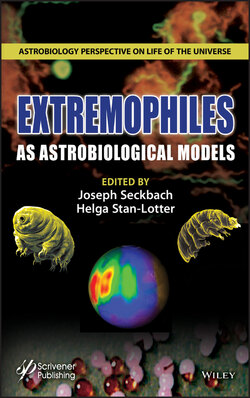Читать книгу EXTREMOPHILES as Astrobiological Models - Группа авторов - Страница 28
1.6 Environmental Models
ОглавлениеModels of the Lassen SW4 iron-oxidizing environment and the Hawai’i H5 salt cave environment are presented below (Figure 1.9 and 1.10) to provide an overview of these habitats.
Figure 1.9 Iron-oxidizing environment. Heated rainwater from magmatic heat convection produces steam that contacts lava and extracts soluble Fe(II). (1) Fe(II) is solubilized in the steam water and (2) rises with steam through porous lava fissures and cracks and reaches the iron vent openings of SW4, as the Fe(II) contacts air (3) Archaea utilize the Fe(II) in their growth by oxidizing the iron to Fe (III). Air oxidation also takes place and adds Fe(III) to the iron-rich layer formed on the solid rocks within the iron vent. (Image credit: the authors).
Figure 1.10 Salt cave environment. (1) Rainwater recharge of the Hawaiian ground water passes slowly through the porous lava rich ground. Fractured lava is heated by the underlying magma and as (2) rainwater descends through crevices and fissures it extracts soluble salts that are present. At greater depths the descending water boils and provides steam and heat so that (3) salts continue to slowly dissolve, rise with steam and deposit as evaporites on a cooler nearby wall, ceiling or as in this model, a shelf. (Image credit: the authors).
Models of the sulfur and ammonia oxidizing environments are available in a previous study [1.3].
